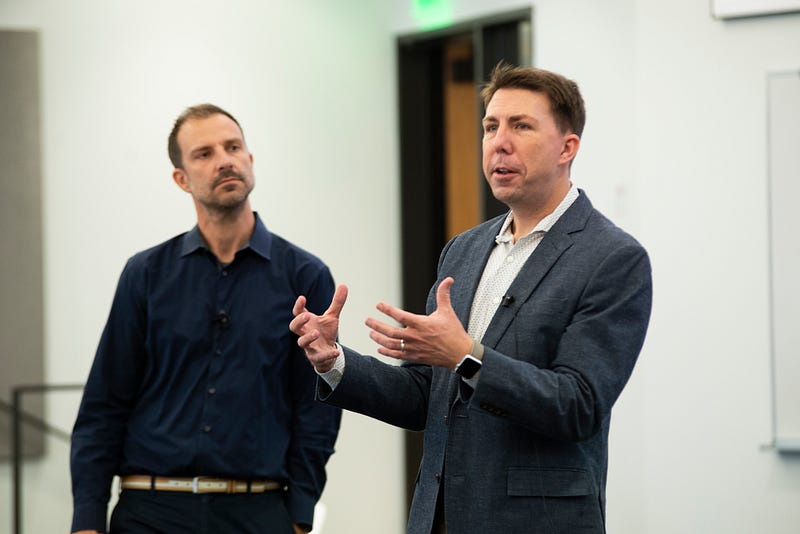To Innovate, Think Like a Designer
Don’t let your innovation engine stall. Apply design thinking for improved results.
By Sloan Wyatt

Design should not only be feasible, but it also needs to be desirable for customers in order to succeed, according to Senior Lecturer Stephen Walls and strategy and innovation firm Upstream founding partner Jeff Mulhausen.
Walls, MBA ’96, and Mulhausen think of design as an approach involving three components: problem seeking, problem-solving, and implementation.
Problem seeking requires not only defining problems in the market but also empathizing with the customer. In order to create a robust innovation, you need to understand the customer’s wants, feelings, and needs.
At the Texas McCombs Presents speaker series talk on Sept. 27, Walls and Mulhausen shared their knowledge of design and design thinking, an increasingly popular approach to addressing the challenge of innovation across a diverse set of businesses.” Design is an agent for change, Walls explained, while design thinking is a human-centered process that uses tools to create more options for innovation.
Innovation at All Levels
Companies too often seek to innovate only at the product and service level. That leaves firms stuck, unable to make bigger leaps, said Mulhausen.
To combat this, Walls and Mulhausen suggest thinking of innovation as levels: transformation, adjacent, and incremental. Transformational innovation creates entirely new businesses to serve different markets and customers. It often requires new capabilities or distribution. Adjacent innovation entails expansion to related business or customer segments, allowing the company to leverage its expertise or capabilities in new ways. Finally, incremental innovation serves existing customers or markets, potentially through new, improved, refined, or “incrementally better” products or services.
“What we need to drive innovation is a much deeper understanding of what’s happening in people’s lives,” Walls said. “The experiences they have, what they’re trying to achieve through those experiences, and the challenges they face in those experiences.”
Understanding Your Customer
Project goals can frequently seem distant and monumental, so Walls and Mulhausen suggest using approaches and tools to produce incremental improvements. One of the ways to create these improvements is by getting to know your audience and their stories — collecting “thick” data over purely quantitative or big data.
At the heart of great innovation is empathy. Seeing your customer as more than a number but rather as a human with wants and needs separates your product from others because it helps you to tackle the problems that matter.
Crafting Challenge Statements and Laddering
Before companies come up with product design, they need to know the requirements for their product, Walls and Mulhausen advise. They recommend first looking at the problem areas that have been identified, and then, companies need to create a challenge statement.
According to Walls and Mulhausen, challenge statements begin by asking “how might we…” This question forces the company to think about the business areas impacted, target audience, and desired outcome. In their example, Walls and Mulhausen asked, “How might we minimize the time needed by cancer survivors to navigate the financial implications of living with cancer?” Using this question, the company can either narrow or widen the scope of the problem. From a “ladder up” perspective, one might wonder, “How might we minimize the time needed by cancer survivors to navigate cancer?” while as from a “ladder down” perspective, one might focus on minimizing the time needed by cancer survivors to compare the costs of drug options. “It becomes particularly important because the way that you frame the problem, drives the outcome that you’re going to get,” Mulhausen said. Companies should be able to answer why they are addressing a particular problem, as well as pinpointing any challenges they face to see what could stop them from solving that problem.
“Design thinking for the purpose of today is going in with a people-centered lens, Mulhausen said. “That’s often what’s missing in organizations. Our approach is going to be anchored in the people and understanding each other.”
Generating Ideas
The idea generation process can face a difficult roadblock: a lack of intention. Walls and Mulhausen say divergent thinking can solve that challenge. As opposed to convergent thinking, which seeks one solution to a problem, divergent thinking identifies multiple, possible solutions to either a singular or set of problems.
“People have this assumption that design is creative people getting together and making choices,” Walls said. But it’s really about implementing a process with steps that produce outcomes. “Each one of those that are really intentional to get us to the next stage and be more successful.”
About this Post
Share:


